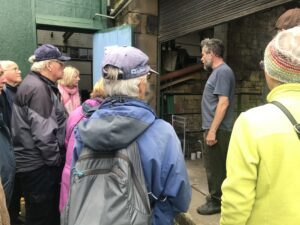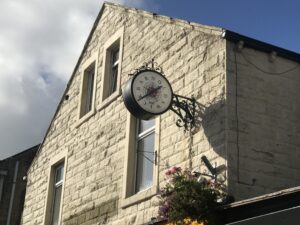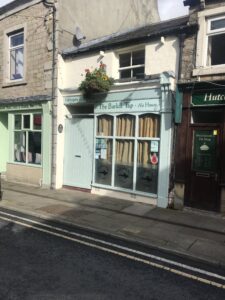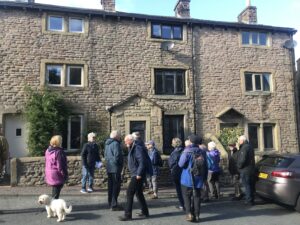It was a lovely sunny afternoon when Bob Abel conducted a good group of Friends around the township of Barnoldswick.

Barnoldswick. October 2022.
Yes, we did see the site of Monastery, which apparently wasn’t there long enough to leave any visible remains before the monks decamped to Kirkstall near Leeds to set up an Abbey there. The villagers probably thought this was a good move as there was so much friction between the two parties that the Pope was called on to intervene in matters. The reputation Barlick has locally for ‘living o’er brush’ might have had something to do with a church that was built and conducted wedding ceremonies without having a wedding licence!

Barnoldswick Time. Town Square. October 2022.
Mills, there were plenty at one time in Barlick, mostly cotton mills. At Bancroft Mill the James and Mary Jane engines produced 200,000 yards of cloth per week from 1,200 weaving looms. Now only the engine house is left and we had an informative and entertaining tour of the Bancroft Mill Engine Museum which has become a charity and is preserving the industrial heritage of the last working steam mill in the area. We also saw saw old mill ponds, now infilled and mill leats and an old saw mill site.

Site of the first Co-op building in Barlick.
Climbing the Forty Steps at Ouzledale we also came across narrow village paths which were cobbled, no doubt to enable the weavers to get to work more easily and quickly.
As for more, there was plenty. The clock in the town square has no figures but spells the word Barnoldswick on the hours. Apparently Barlick is the longest village name in the country and it doesn’t have any repeating letters. Around Walmgate we were in one of the oldest areas of the town. The road here used to be very steep but was infilled by several feet. We saw the site of the old village green near here also and the site of the police lock up.

Weavers Cottages. Barlick. October 2022.
Barlick Tap, a modest building was the site of the first Co-op in the town.In 1854 there were no more than 20 members, sixty years later the numbers grew to 1,850. Of course in a mill town there are houses which had upper floor weaving rooms which pre dated the mills and we saw several examples in the town.
All in all a very enjoyable and informative afternoon.
Image attributions: G Wray